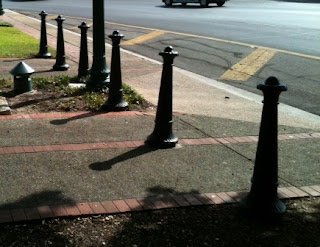During an extended break in my recent jury duty in district court I remembered that a Fiber Art exhibition had been showing in the downtown gallery in New Braunfels. I made my way down there and was extremely gratified to find out that it was still on display.
 |
| FUCHSIA NECKTIE © 2012, Nadia Kahn photograph © 2012, Bill Brockmeier |
The range of style, approach and technique shown throughout the show is remarkable. There are small scale but serious works, like seen in the vertical showcase housing an incredible array of birdnest-like baskets. The colors, textures, and details displayed by this collection is wonderful. And then there are large, elegant, and thought-provoking works like the huge, vertically oriented silk design wafting in the breeze of the overhead fans.
While fiber-based works are not at the top of my mind when I think of creative pursuits, whenever I have the opportunity to view some serious examples I am always impressed by the possibilities. It's astounding to realize how this media can cover much of the same ground as painting, sculpture, architecture, and even photography. On top of that, you can even wear some of it!
The Feminine Thread
Though most of the works in the show are abstract creations meant to be displayed by hanging on the wall or standing on a table, there are certainly many that were made to be displayed on the human body. Of these, the great majority were scarves, hats, jackets, and dresses that were clearly intended to compliment the feminine form. And I suppose that is as it should be. Of the twenty two artists showing their work there, every one of them is a woman. Of course, not every single fiber artist in the world is a woman, but there does seem to be some sort of natural bond between the feminine psyche and the "thread." |
| SPOTTED RED NECKTIE
© 2012, Nadia Kahn photograph © 2012, Bill Brockmeier |
The Masculine Scarf
Not every item of apparel in the show was intended for the feminine form. There was a trio of neckties that caught my attention. Even if not worn on the body these ties could be marvelous abstract paintings, worthy of framing and hanging on a wall in a place of prominence. Their colors were sumptuous and their designs intruiguing. On top of that, they were fabricated from silk, insuring a tactile sensation satisfaction.I'm a sucker for the feel of certain fabrics. Some of my earliest treasured memories (before I entered school) are times that I accompanied my mother to the various fabric stores she frequented. I loved leaving her behind as she scouted the store for some specific need. I would find my own adventures among the endless aisles of bolts of fabric that towered above my four year old frame. The colors and patterns alone were amazing enough to the sensation-sponge that was my mind, but what really hooked me was the way these fabrics felt to my little fingers and face. I couldn't help but touch them. To this day I can't go into a fabric store and only look.
Like the majority of men these days (at least those born post-mid-twentieth-century) I was not at first a fan of the "noose." I viewed neckties as not-quite-necessary evils to be endured only once or twice a year, and I would avoid that if at all possible. But several years ago I began to see them as something else. They seemed to have become such a rarely worn item around a man's neck that they have now transcended what they once were– a required uniform of drudgery– and are now a new freedom, offering a unique and refreshing opportunity for a man to wear art. A generation or two ago, our culture afforded only women the common luxury of being draped with beautiful designs and creations. Now men can just as easily (though maybe not as naturally) don the beautiful. (...and if you need to learn how to tie a necktie, check out these manly videos...)
So, I paid for the two ties whose colors I especially appreciated and told the gallery docents I would be back to pick them up at the close of the show. I am looking forward to wearing these ties at the Texas Hill Country Invitational show in which I will participate the third weekend of October. Come see me there, and I might even let you touch my tie!
By the way— the beautiful neckties I now possess (and illustrated above) were painted by Nadia Kahn, an incredible silk artist whom you can contact at: NadiaKahnSilks@gmail.com


.jpg)
.jpg)